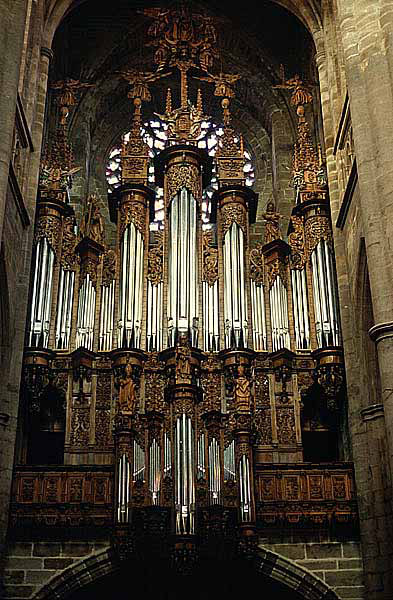


Rodez (Aveyron), Cathédrale Notre-Dame

Claude Guillemin and Antoine Vernholles 1627-28, case by Raymond Gusmond; expanded by Andre Eustache 1657; widely renovated by Jean de Joyeuse 1676
State of preservation:
Generar renewals1728 and 1749 by François and his son Jean-François Lepiné, in 1775-76 by Joseph Isnard; in spite of furhter radical renewals during the 19th century about 1000 pipes of the 17th and 18th centuries still exist. The restorations by Koenig preserved the older pipe material.
After this constant flow of renewals and expansions with all their radical changes in technical and sound structure, case and statics of the organ, restoration was a highly problematic issue. None of the recorded stages of the instrument could be reestablished in total, so the instrument today resembles an “ideal” organ of the French baroque era.
Specification
IV+P
Grand Orgue:
Montre 16’
Bourdon 16’
Montre 8’
Bourdon 8’
Cornet [8’] 5f.
Prestant 4’
Flûte 4’
Grande Tierce 3 1/5’
Nazard 2 2/3’
Doublette 2’
Quarte 2’
Tierce 1 3/5’
Flageolet 1’
Fourniture 5f.
Cymbale 4f.
1ère Trompette 8’
2è Trompette 8’
Clairon 4’
Positif:
Montre 8’
Bourdon 8’
Prestant 4’
Flûte 4’
Nazard 2 2/3’
Doublette 2’
Tierce 1 3/5’
Larigot 1 1/3’
Fourniture 4f.
Cymbale 3f.
Trompette 8’
Cromorne 8’
Voix humaine 8’
Récit: (from g0)
Cornet [8’]
Trompette 8’
Hautbois 8’
Écho: (from c0)
Bourdon 8’
Prestant 4’
Nazard 2 2/3’
Doublette 2’
Tierce 1 3/5’
Cymbale 3f.
Voix humaine 8’
Pédale:
Flûte 16’
Flûte 8’
Flûte 4’
Bombarde 16’
Trompette 8’
Clairon 4’
Couplers Pos/GO, GO/P, Tremblant doux
© Greifenberger Institut für Musikinstrumentenkunde | info@greifenberger-institut.de



